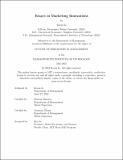Essays in Marketing Innovations
Author(s)
Li, Keyan
DownloadThesis PDF (4.573Mb)
Advisor
Simester, Duncan
Zhang, Juanjuan
Terms of use
Metadata
Show full item recordAbstract
The dissertation consists of three chapters on understanding marketing innovations, including targeted marketing and new product development.
The first chapter studies a novel targeting problem that many firms face and develops a new method for targeting experimentation. Adaptive learning policies that guide how firms trade off acquiring new information to improve a current targeting policy, versus exploiting the current policy to harvest, typically focus on settings in which customers arrive individually, in a frequent sequence. However, in practice, firms often conduct marketing campaigns in batches, in which they target a large group of customers with personalized marketing actions together. This has an important implication for how firms resolve the tradeoff between acquiring new information and exploiting the current policy. The large number of customers in each batch (campaign) introduces an information externality: the incremental information contributed by a single customer depends upon the assignment decisions for other customers in the batch. We investigate how to optimally acquire and coordinate information in these settings. The algorithm we propose uses Gaussian processes to estimate the value of incremental information, while accounting for the information externality between customers in the same batch. Findings are validated using data from a field experiment.
The second chapter studies customer demand in a non-market-oriented economy. The economics and marketing literature has primarily focused on market economies and studied factors such as price and advertising when analyzing customer demand. However, in non-market-oriented economies, social factors like corruption can have a significant influence on customer decisions. In particular, this paper focuses on the demand for luxury products, which are widely used for gift-giving and even bribery in emerging markets. One possible mechanism is that when the relative size of non-market-oriented sectors in the local economy increases, luxury products can be used to identify those who have a higher willingness to pay for scarce resources. As a result, the demand for luxury products moves together with the degree of corruption. By leveraging natural experiments of top-down anti-corruption campaigns that temporarily halt this channel, an empirical study is performed using a comprehensive dataset that covers the sales of all cigarette brands and the local social environment in China. The results suggest that these social factors can have an unanticipated impact on the demand for luxury products.
The third chapter studies how customer search can stifle product innovations. Conventional wisdom suggests that when an incumbent fails to innovate, there is a greater risk to the incumbent of competition from other innovators. I show conditions in which the opposite is true: by delaying innovation, an incumbent can create entry barriers that deter innovation by competitors. Consequently, both competition and innovation are suppressed. The key insight driving these outcomes is that customer search is endogenous, and absence of innovation today can disincentivize customers from searching in the future. Since customers need to search to discover innovations, when they search less, it both creates entry barriers for competitors, and reduces the competitors' incentives to innovate. Postponing innovation can benefit incumbents if it motivates customers to search less, and thus competitors to innovate less. Notably, I show that searching less is a rational customer response.
Date issued
2024-05Department
Sloan School of ManagementPublisher
Massachusetts Institute of Technology